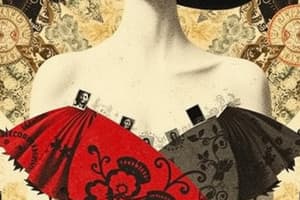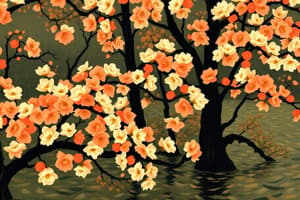Podcast
Questions and Answers
What is the silhouette in fashion design?
What is the silhouette in fashion design?
- The fabric used in construction.
- The choice of colors in a garment.
- The patterns used in the design.
- The overall shape or outline of a garment. (correct)
Which element of fashion design is crucial for determining mood and appeal?
Which element of fashion design is crucial for determining mood and appeal?
- Texture
- Color (correct)
- Construction
- Silhouette
What is the final phase of the fashion design process?
What is the final phase of the fashion design process?
- Final Design (correct)
- Sketching
- Research and Inspiration
- Prototyping
What characterizes haute couture designers?
What characterizes haute couture designers?
Which of the following is NOT a phase in the fashion design process?
Which of the following is NOT a phase in the fashion design process?
What is a key skill required for a career in fashion design?
What is a key skill required for a career in fashion design?
How do cultural trends influence fashion?
How do cultural trends influence fashion?
What does fabric choice affect in fashion design?
What does fabric choice affect in fashion design?
Flashcards are hidden until you start studying
Study Notes
Overview of Fashion Design
- Fashion design is the art of applying design, aesthetics, and natural beauty to clothing and accessories.
- It encompasses a range of disciplines and requires a blend of creativity and technical skills.
Key Elements of Fashion Design
-
Silhouette
- The overall shape or outline of a garment.
- Influences the garment's style and fit.
-
Color
- Crucial for mood and appeal.
- Understanding color theory helps in creating harmonious designs.
-
Fabric
- Material choice impacts texture, drape, and durability.
- Knowledge of fabric properties is essential for design execution.
-
Pattern
- Refers to the recurring motifs or prints used in designs.
- Can enhance the visual interest of a garment.
-
Construction
- The process of assembling the garment, including sewing techniques and finishing touches.
- Quality of construction affects the garment's longevity and wearability.
Phases of Fashion Design Process
-
Research and Inspiration
- Gathering ideas from various sources (art, nature, culture).
- Analyzing trends and consumer behavior.
-
Sketching
- Initial design concepts are visualized through drawings.
- Helps in refining ideas before actual production.
-
Prototyping
- Creating sample garments to test designs.
- Evaluates fit, comfort, and overall look.
-
Final Design
- Finalizing designs based on prototypes and feedback.
- Includes detailed specifications for production.
-
Production
- Mass production of the final designs.
- Involves sourcing materials and managing quality control.
Types of Fashion Designers
-
Haute Couture Designers
- Create custom, high-end fashion pieces.
- Focus on craftsmanship and exclusive designs.
-
Ready-to-Wear Designers
- Produce garments made for mass consumption.
- Balance style with practicality and affordability.
-
Costume Designers
- Specialize in designing outfits for theater, film, and television.
- Focus on character representation and historical accuracy.
Fashion Design Influences
-
Cultural Trends
- Fashion reflects social, political, and cultural movements.
-
Technology
- Advances in textile technology and design software impact the industry.
-
Sustainability
- Increasing focus on eco-friendly materials and ethical production practices.
Career in Fashion Design
-
Skills Required
- Creativity, drawing, sewing, and fabric knowledge.
- Business acumen for marketing and branding.
-
Education
- Formal education often includes degrees in fashion design or related fields.
-
Networking
- Building relationships within the industry is crucial for success.
Conclusion
- Fashion design is a dynamic field that fuses artistic expression with practical application.
- Successful designers must stay informed about trends, techniques, and consumer needs.
Overview of Fashion Design
- Fashion design merges art, aesthetics, and beauty with clothing and accessories.
- It requires a combination of creativity and technical expertise to succeed.
Key Elements of Fashion Design
- Silhouette
- Defines garment shape and outline; affects style and fit.
- Color
- Essential for setting mood and attraction; mastery of color theory aids design harmony.
- Fabric
- Choice influences texture, flow, and durability; understanding fabric characteristics is critical.
- Pattern
- Involves recurring designs that enhance garment appeal; increases visual interest.
- Construction
- Involves garment assembly, including sewing methods; craftsmanship impacts longevity and usability.
Phases of Fashion Design Process
- Research and Inspiration
- Ideas drawn from diverse sources such as art and culture; trend analysis is essential.
- Sketching
- Visual representation of design ideas; critical for refining concepts before production.
- Prototyping
- Development of sample garments to assess design viability; focuses on fit and aesthetics.
- Final Design
- Completion of designs informed by prototype evaluations; includes detailed production specifications.
- Production
- Mass manufacturing of designs; involves sourcing materials and quality management.
Types of Fashion Designers
- Haute Couture Designers
- Create high-end, custom pieces emphasizing craftsmanship and exclusivity.
- Ready-to-Wear Designers
- Design garments for mass distribution that balance style with accessibility.
- Costume Designers
- Focus on creating outfits for performing arts, emphasizing character and historical context.
Fashion Design Influences
- Cultural Trends
- Fashion serves as a reflection of societal changes and movements.
- Technology
- Innovations in textiles and design software are reshaping industry practices.
- Sustainability
- Growing emphasis on eco-friendly materials and ethical manufacturing processes.
Career in Fashion Design
- Skills Required
- Essential skills include creativity, drawing, sewing, and a solid understanding of fabrics.
- Business knowledge is vital for effective marketing and branding.
- Education
- Formal education typically includes fashion design degrees or related fields.
- Networking
- Building industry relationships is crucial for professional growth and opportunities.
Conclusion
- Fashion design is a vibrant field that combines artistic creativity with practical applicability.
- Successful designers must remain updated on trends, techniques, and market needs.
Studying That Suits You
Use AI to generate personalized quizzes and flashcards to suit your learning preferences.




